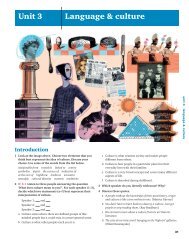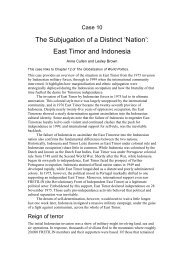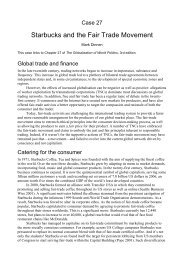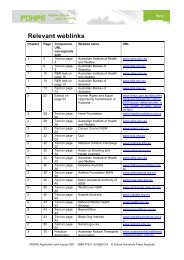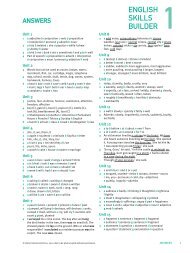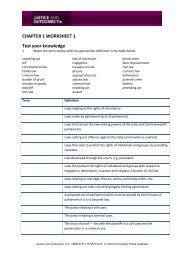2 Chapter 6 ⢠organising elements Organising elements
2 Chapter 6 ⢠organising elements Organising elements
2 Chapter 6 ⢠organising elements Organising elements
You also want an ePaper? Increase the reach of your titles
YUMPU automatically turns print PDFs into web optimized ePapers that Google loves.
8<br />
1894<br />
William Ramsay, a Scottish chemist,<br />
used the then new technology<br />
of refrigeration to liquefy and<br />
separate the components of air. He<br />
successfully removed water, carbon<br />
dioxide, oxygen and nitrogen, but<br />
found he had some unknown gas left<br />
behind. This was argon, the first in<br />
its group to be discovered. Further<br />
experimentation identified helium,<br />
neon, krypton and xenon. All these<br />
gases form the group of noble gases<br />
at the far right of the periodic table.<br />
1940<br />
With the development of nuclear processes,<br />
<strong>elements</strong> heavier than uranium could be<br />
created. The US scientist Glen Seaborg,<br />
winner of the 1951 Nobel Prize in Chemistry,<br />
used a ‘cyclotron’ to slam neutrons into<br />
uranium atoms. This created the very first<br />
atoms of neptunium and plutonium.<br />
Fig 6.7 Atoms heavier than uranium are called the ‘transuranium’<br />
or ‘transuranic’ <strong>elements</strong>. None of them occurs naturally. The<br />
image above shows a sample of neptunium.<br />
Today<br />
Since the 1940s, similar nuclear<br />
processes have been used to<br />
synthesise the <strong>elements</strong> up to and<br />
including element 118. These<br />
<strong>elements</strong> are given names based<br />
on their atomic number: 118 is<br />
called ‘ununoctium’ (1-1-8-ium).<br />
In 2010, six atoms of element<br />
117 were created by bombarding<br />
berkelium (97) with calcium<br />
(20). These six atoms existed for<br />
only a fraction of a second, but<br />
their creation filled a gap in the<br />
periodic table.<br />
<strong>Chapter</strong> 6 • <strong>organising</strong> <strong>elements</strong><br />
1913<br />
By the early 1900s, X-rays could<br />
be used to determine the atomic<br />
number of each element. Using<br />
this technology, a young English<br />
physicist by the name of Henry<br />
Moseley refined the order of some<br />
of the <strong>elements</strong> in Mendeleev’s<br />
periodic table and proposed a minor<br />
change to the periodic law:<br />
‘Elements have properties that<br />
recur or repeat according to<br />
their atomic number.’<br />
Fig 6.6 Henry Moseley’s name is linked to significant advances in X-ray-related chemistry<br />
and physics, with many believing him worthy of a Nobel Prize. His work was cut short<br />
when he died at just 27 years of age in the Battle of Gallipoli during World War I.<br />
What do you know about the<br />
birth of the periodic table?<br />
1 Who was the first chemist to lead a team that made<br />
<strong>elements</strong> that did not occur naturally?<br />
2 When Mendeleev proposed the periodic table, he went<br />
one step further. What else did he do and why is this<br />
significant?<br />
3 Why were the gases that Ramsay discovered not able to<br />
be discovered any earlier?<br />
4 Moseley changed the periodic law proposed by<br />
Mendeleev by changing one word. What word was<br />
changed, and how did this improve the periodic table?<br />
UNCORRECTED PAGE PROOFS<br />
CAS_SB10_TXT_06_1pp.indd 8<br />
11/11/11 4:58 PM





